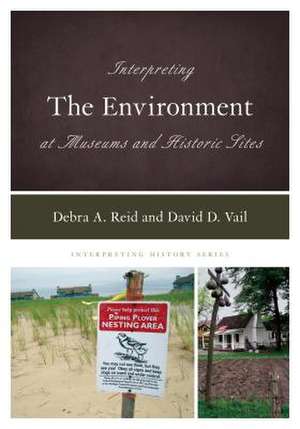Interpreting the Environment at Museums and Historic Sites: Interpreting History
Autor David D. Vailen Limba Engleză Paperback – 12 sep 2019
| Toate formatele și edițiile | Preț | Express |
|---|---|---|
| Paperback (1) | 413.26 lei 6-8 săpt. | |
| Rowman & Littlefield – 12 sep 2019 | 413.26 lei 6-8 săpt. | |
| Hardback (1) | 688.79 lei 6-8 săpt. | |
| Rowman & Littlefield – 18 sep 2019 | 688.79 lei 6-8 săpt. |
Din seria Interpreting History
-
 Preț: 309.49 lei
Preț: 309.49 lei -
 Preț: 325.64 lei
Preț: 325.64 lei - 23%
 Preț: 550.97 lei
Preț: 550.97 lei -
 Preț: 314.82 lei
Preț: 314.82 lei -
 Preț: 437.14 lei
Preț: 437.14 lei -
 Preț: 311.93 lei
Preț: 311.93 lei -
 Preț: 300.07 lei
Preț: 300.07 lei -
 Preț: 322.67 lei
Preț: 322.67 lei -
 Preț: 370.34 lei
Preț: 370.34 lei -
 Preț: 432.59 lei
Preț: 432.59 lei -
 Preț: 365.93 lei
Preț: 365.93 lei -
 Preț: 395.36 lei
Preț: 395.36 lei -
 Preț: 400.83 lei
Preț: 400.83 lei -
 Preț: 365.55 lei
Preț: 365.55 lei -
 Preț: 369.06 lei
Preț: 369.06 lei - 23%
 Preț: 647.06 lei
Preț: 647.06 lei -
 Preț: 394.39 lei
Preț: 394.39 lei -
 Preț: 352.70 lei
Preț: 352.70 lei - 23%
 Preț: 514.78 lei
Preț: 514.78 lei -
 Preț: 299.51 lei
Preț: 299.51 lei - 23%
 Preț: 602.85 lei
Preț: 602.85 lei
Preț: 413.26 lei
Nou
Puncte Express: 620
Preț estimativ în valută:
79.07€ • 82.57$ • 65.30£
79.07€ • 82.57$ • 65.30£
Carte tipărită la comandă
Livrare economică 15-29 aprilie
Preluare comenzi: 021 569.72.76
Specificații
ISBN-13: 9781538115497
ISBN-10: 1538115492
Pagini: 180
Dimensiuni: 178 x 254 x 14 mm
Greutate: 0.4 kg
Editura: Rowman & Littlefield
Seria Interpreting History
ISBN-10: 1538115492
Pagini: 180
Dimensiuni: 178 x 254 x 14 mm
Greutate: 0.4 kg
Editura: Rowman & Littlefield
Seria Interpreting History
Notă biografică
Debra A. Reid, PhD, is curator of agriculture and the environment at The Henry Ford. She saw the landscape through new eyes after earning minor in Historical Geography at Southeast Missouri State University, studying with Michael Roark. She completed a minor field in Geography, studying with Peter Hugill, and her PhD in History at Texas A&M University. She taught in the Department of History at Eastern Illinois University from 1999 through 2016 before joining The Henry Ford.
David D. Vail, PhD, has training in environmental history, agricultural history, and science and technology, earning a PhD at Kansas State University. He is assistant professor in the Department of History at the University of Nebraska at Kearney. His book, Chemical Lands: Pesticides, Aerial Spraying, and Health in North Americäs Grasslands since 1945 (University of Alabama Press, 2018) is part of the NEXUS Series: New Histories of Science, Technology, the Environment, Agriculture, and Medicine). He is book review editor for The Public Historian (National Council on Public History), and a member of the editorial committee for Agricultural History.
Descriere
Interpreting the Environment at Museums and Historic Sites is for anyone wants to become a better steward of the environment and share lessons learned with others. The book provides a primer on "major problems" in researching about the environment and re-focuses thinking about the environment to thinking from the perspective of place and time.
